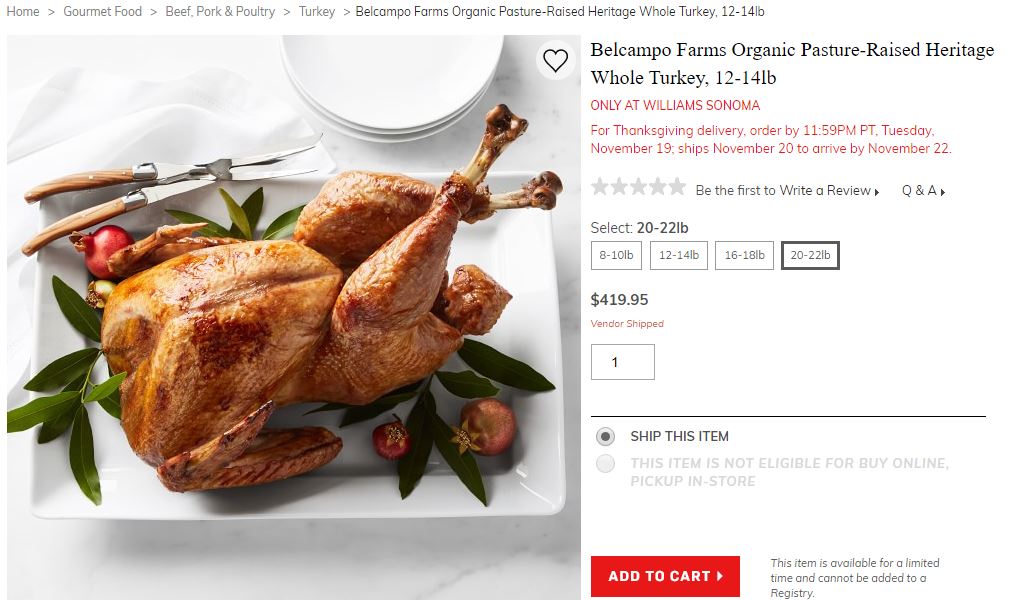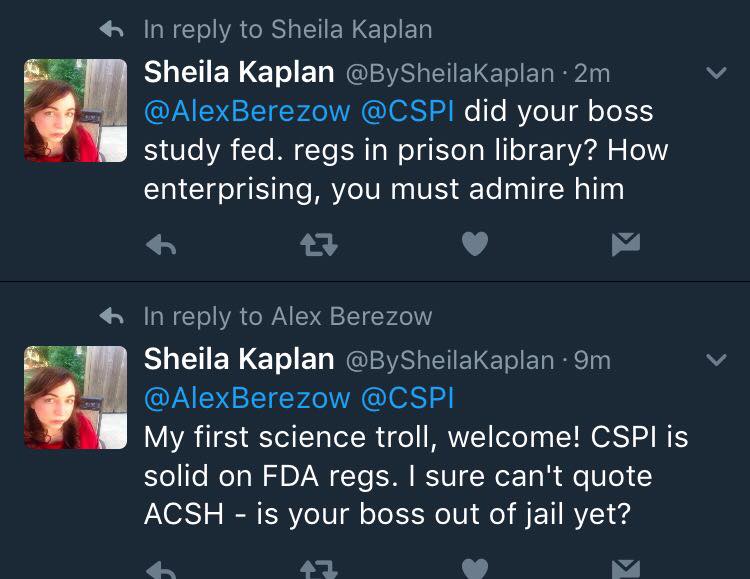Let's say your Generation Z child is concerned about chemicals in your Thanksgiving meal and you want to avoid that awkward moment when they don't look up from their phones while saying "OK Boomer" as you try to explain to them that all food has chemicals.
Maybe they just don't want scientific chemicals. Maybe they want the organic kind that are healthier, according to, well, organic industry trade groups and journalists at the Mother Jones company.
So you trudge off to Whole Foods or a store you read about on a Facebook page and buy the stuff on your menu, all certified expensive. I hate to alarm you but it all has chemicals that are known carcinogens. That's right, they cause cancer.
I don't want to make you ill, so I will note for you what scaremongers in activist groups and the trial lawyers supporting them for profit (Center for Science in the Public Interest, et al.) don't reveal. While these carcinogens are in your organic or regular-priced meal, except for alcohol, they only cause cancer in rats. And rats are not little people. Anyone who tries to claim otherwise is looking for coverage from Sheila Kaplan at the New York Times or someone else who only gets their science from lawyers at CSPI.(1)
Here is a sample menu and the toxic chemicals they contain. Again, you can relax. When it comes to France's IARC (International Agency for Research on Cancer) group or the U.S. National Institute of Environmental Health Sciences, rats are people and they only care about the presence of a chemical but chemists, toxicologists, and biologists know better. Those epidemiologists are not trying to do science, they are out to create a statistical correlation using a hazard. They don't consider risk, so they will use 5 orders of magnitude for dose. That's right, they consider one beer as the same as 10,000 beers all consumed at the same time. That's why you can't use their claims as anything more than exploratory, a lesson more journalists and California's Prop 65 panel should learn.
Here are the cancer-causing chemicals in even your organic Thanksgiving meal.
STARTERS

Stuffing - Some of the ones mentioned above plus acrylamide, dihydrazines and more.
Tomato Risotto - Lycopene
Grilled Asparagus - Saponins
Grilled Pepper Crusted Filet of Beef - N-nitroso compounds
Bordelaise Sauce - Ethanol
Cranberry sauce - furan derivatives, which are mutagens (see the Great Cranberry Scare of 1959 for more)

DESSERT
Chocolate Cake - Polycyclic aromatic hydrocarbons
Vanilla Crème Anglaise - Benzene
Fresh Raspberries - Quercetin
Coffee - Freshly Brewed Acrylamide plus hydrogen peroxide, a mutagen and rodent carcinogen
Decaffeinated Coffee - Furan
Herbal and Caffeinated Teas - Variety of Benzo[A]pyran
Pumpkin pie - Benzo(a)pyrene, coumarin, methyl eugenol and safrole
NOTE:
(1) I am not kidding. In 2016 I was running ACSH and when Dr. Alex Berezow criticized her for using CSPI on a science issue instead of a scientist, in retaliation she tried to claim I was a ... felon. Now, I did have a speeding ticket one time, but that is not a felony, even in California. Still, attacking the science media community was enough to land her a job at the New York Times. Next up, a "visiting fellow" appointment to the New York University Arthur L. Carter Journalism Institute. It is where all journalists who undermine science get the call.

Maybe they just don't want scientific chemicals. Maybe they want the organic kind that are healthier, according to, well, organic industry trade groups and journalists at the Mother Jones company.
So you trudge off to Whole Foods or a store you read about on a Facebook page and buy the stuff on your menu, all certified expensive. I hate to alarm you but it all has chemicals that are known carcinogens. That's right, they cause cancer.
I don't want to make you ill, so I will note for you what scaremongers in activist groups and the trial lawyers supporting them for profit (Center for Science in the Public Interest, et al.) don't reveal. While these carcinogens are in your organic or regular-priced meal, except for alcohol, they only cause cancer in rats. And rats are not little people. Anyone who tries to claim otherwise is looking for coverage from Sheila Kaplan at the New York Times or someone else who only gets their science from lawyers at CSPI.(1)
Here is a sample menu and the toxic chemicals they contain. Again, you can relax. When it comes to France's IARC (International Agency for Research on Cancer) group or the U.S. National Institute of Environmental Health Sciences, rats are people and they only care about the presence of a chemical but chemists, toxicologists, and biologists know better. Those epidemiologists are not trying to do science, they are out to create a statistical correlation using a hazard. They don't consider risk, so they will use 5 orders of magnitude for dose. That's right, they consider one beer as the same as 10,000 beers all consumed at the same time. That's why you can't use their claims as anything more than exploratory, a lesson more journalists and California's Prop 65 panel should learn.
Here are the cancer-causing chemicals in even your organic Thanksgiving meal.
STARTERS
Organic Baby Greens - Nitrates and 3-O-(2’’-O-methylmalonnyl-β-D glucopyranoside)-4’-O-β-D-glucopyranoside
Roasted Golden and Red Beets - Caffeic acid
Crumbled Goat Cheese -Estrogen (endocrine disrupting chemical)
Grape Tomatoes - Solanine neurotoxin
Candied Walnuts - Aflatoxins
Dijon Dressing - Allyl isothiocyanate
Celery - Caffeic acid
Broccoli - Allyl isothiocyanate
Rolls with butter - Acetaldehyde, benzene, ethyl carbonate.
ENTREES
Potatoes - Dolanine, arsenic, chaconine, caffeic acid and ethyl alcohol, that last one is also a human carcinogen.
Turkey - Heterocyclic amines, rodent carcinogens and mutagens. Even that $400 "Heritage" turkey from Williams-Sonoma.

Stuffing - Some of the ones mentioned above plus acrylamide, dihydrazines and more.
Tomato Risotto - Lycopene
Grilled Asparagus - Saponins
Grilled Pepper Crusted Filet of Beef - N-nitroso compounds
Bordelaise Sauce - Ethanol
Cranberry sauce - furan derivatives, which are mutagens (see the Great Cranberry Scare of 1959 for more)

DESSERT
Chocolate Cake - Polycyclic aromatic hydrocarbons
Vanilla Crème Anglaise - Benzene
Fresh Raspberries - Quercetin
Coffee - Freshly Brewed Acrylamide plus hydrogen peroxide, a mutagen and rodent carcinogen
Decaffeinated Coffee - Furan
Herbal and Caffeinated Teas - Variety of Benzo[A]pyran
Pumpkin pie - Benzo(a)pyrene, coumarin, methyl eugenol and safrole
NOTE:
(1) I am not kidding. In 2016 I was running ACSH and when Dr. Alex Berezow criticized her for using CSPI on a science issue instead of a scientist, in retaliation she tried to claim I was a ... felon. Now, I did have a speeding ticket one time, but that is not a felony, even in California. Still, attacking the science media community was enough to land her a job at the New York Times. Next up, a "visiting fellow" appointment to the New York University Arthur L. Carter Journalism Institute. It is where all journalists who undermine science get the call.
